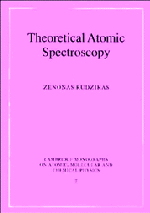Book contents
- Frontmatter
- Contents
- Preface
- Foreword to the Paperback Edition
- Introduction
- Part 1 Energy Spectrum of Many-electron Atom. Radiative and Autoionizing Transitions (Initial Formulas)
- Part 2 Foundations of the Angular Momentum Theory. Graphical Methods
- Part 3 Description of Complex Electronic Configurations
- 9 Non-relativistic and relativistic cases of a shell of equivalent electrons
- 10 Two and more shells of equivalent electrons
- 11 Classification of energy levels
- 12 Relations between various coupling schemes
- Part 4 Second-quantization in the Theory of an Atom. Quasispin and Isospin
- Part 5 Matrix Elements of the Energy Operator
- Part 6 Electric and Magnetic Multipole Transitions
- Part 7 Calculation of Energy Spectra and Electronic Transitions in the Case of Complex Configurations
- Epilogue
- References
- Index
9 - Non-relativistic and relativistic cases of a shell of equivalent electrons
Published online by Cambridge University Press: 21 September 2009
- Frontmatter
- Contents
- Preface
- Foreword to the Paperback Edition
- Introduction
- Part 1 Energy Spectrum of Many-electron Atom. Radiative and Autoionizing Transitions (Initial Formulas)
- Part 2 Foundations of the Angular Momentum Theory. Graphical Methods
- Part 3 Description of Complex Electronic Configurations
- 9 Non-relativistic and relativistic cases of a shell of equivalent electrons
- 10 Two and more shells of equivalent electrons
- 11 Classification of energy levels
- 12 Relations between various coupling schemes
- Part 4 Second-quantization in the Theory of an Atom. Quasispin and Isospin
- Part 5 Matrix Elements of the Energy Operator
- Part 6 Electric and Magnetic Multipole Transitions
- Part 7 Calculation of Energy Spectra and Electronic Transitions in the Case of Complex Configurations
- Epilogue
- References
- Index
Summary
In previous chapters we considered the wave functions and matrix elements of some operators without specifying their explicit expressions. Now it is time to discuss this question in more detail. Having in mind that our goal is to consider as generally as possible the methods of theoretical studies of many-electron systems, covering, at least in principle, any atom or ion of the Periodical Table, we have to be able to describe the main features of the structure of electronic shells of atoms. In this chapter we restrict ourselves to a shell of equivalent electrons in non-relativistic and relativistic cases.
A shell of equivalent electrons
The non-relativistic wave function (1.14) or its relativistic analogue (2.15), corresponds to a one-electron system. Having in mind the elements of the angular momentum theory and of irreducible tensors, described in Part 2, we are ready to start constructing the wave functions of many-electron configurations. Let us consider a shell of equivalent electrons. As we shall see later on, the pecularities of the spectra of atoms and ions are conditioned by the structure of their electronic shells, and by the relative role of existing intra-atomic interactions.
N electrons with the same values of quantum numbers nili (LS coupling) or niliji (jj coupling) are called equivalent. The corresponding configurations will be denoted as nlN (a shell) or nl jN (a subshell). A number of permitted states of a shell of equivalent electrons are restricted by the Pauli exclusion principle, which requires antisymmetry of the wave function with respect to permutation of the coordinates of the electrons.
The wave function for the particular case of two equivalent electrons may be constructed, using vectorial coupling of the angular momenta and antisymmetrization procedure.
- Type
- Chapter
- Information
- Theoretical Atomic Spectroscopy , pp. 73 - 84Publisher: Cambridge University PressPrint publication year: 1997

